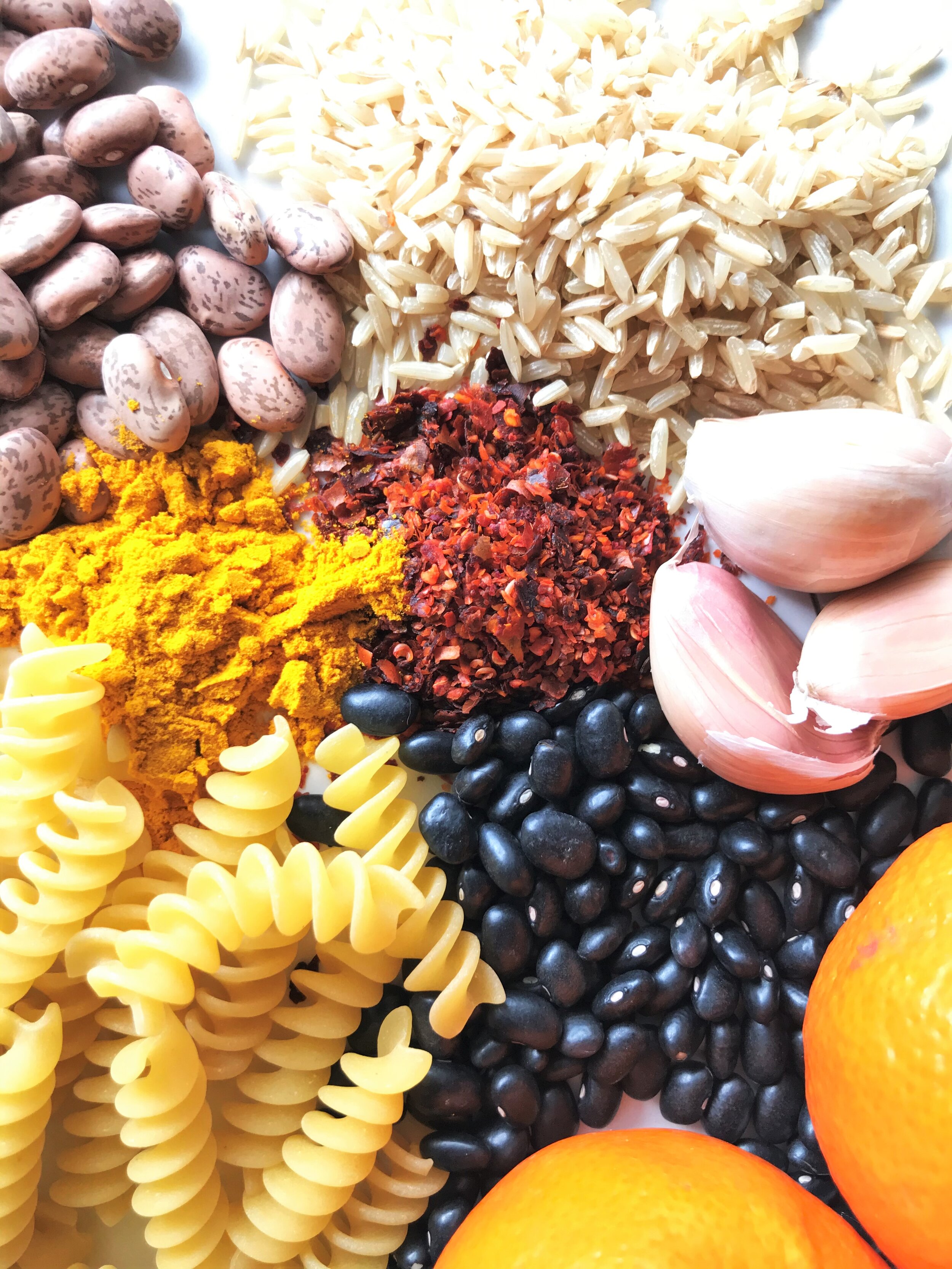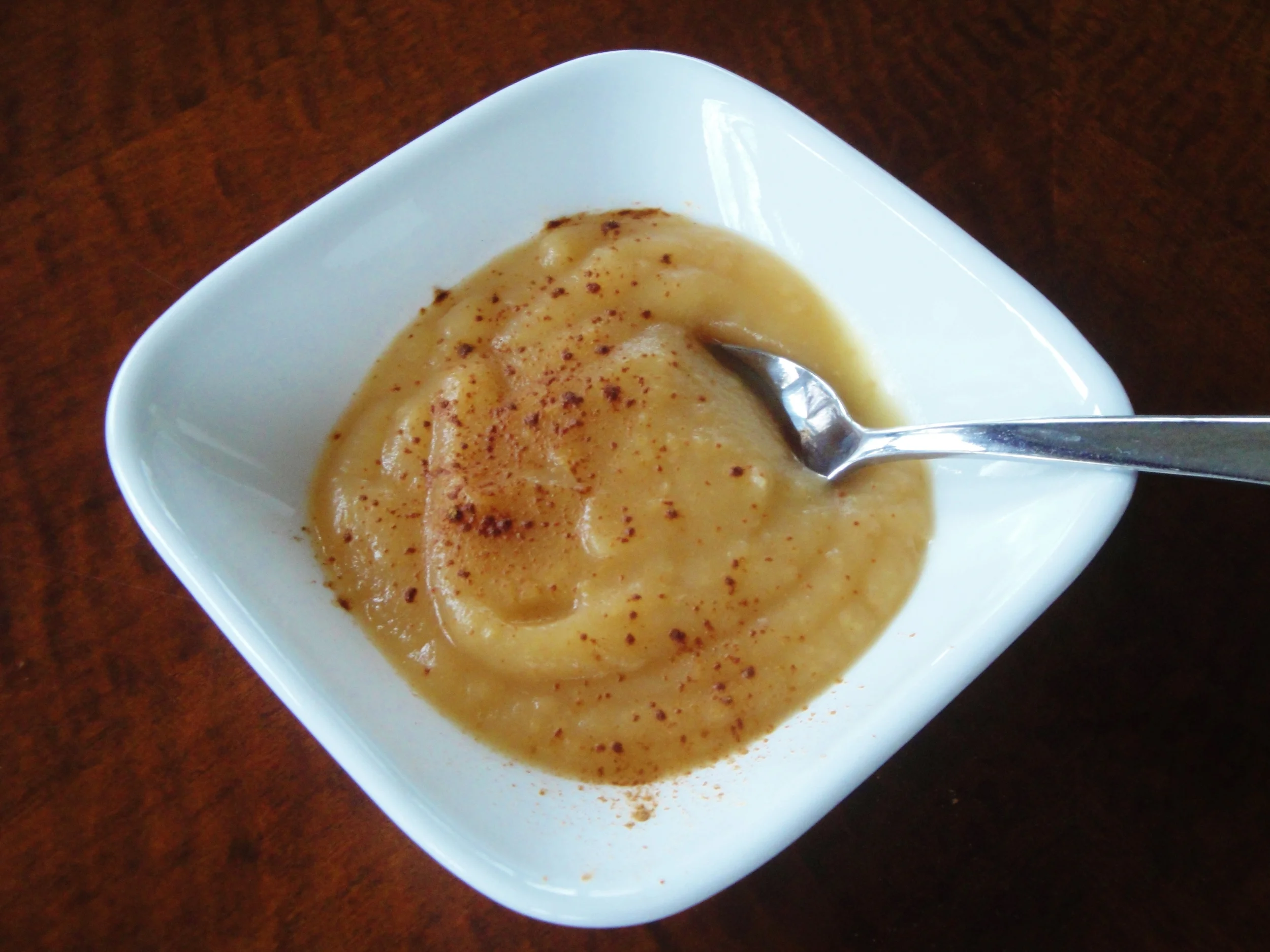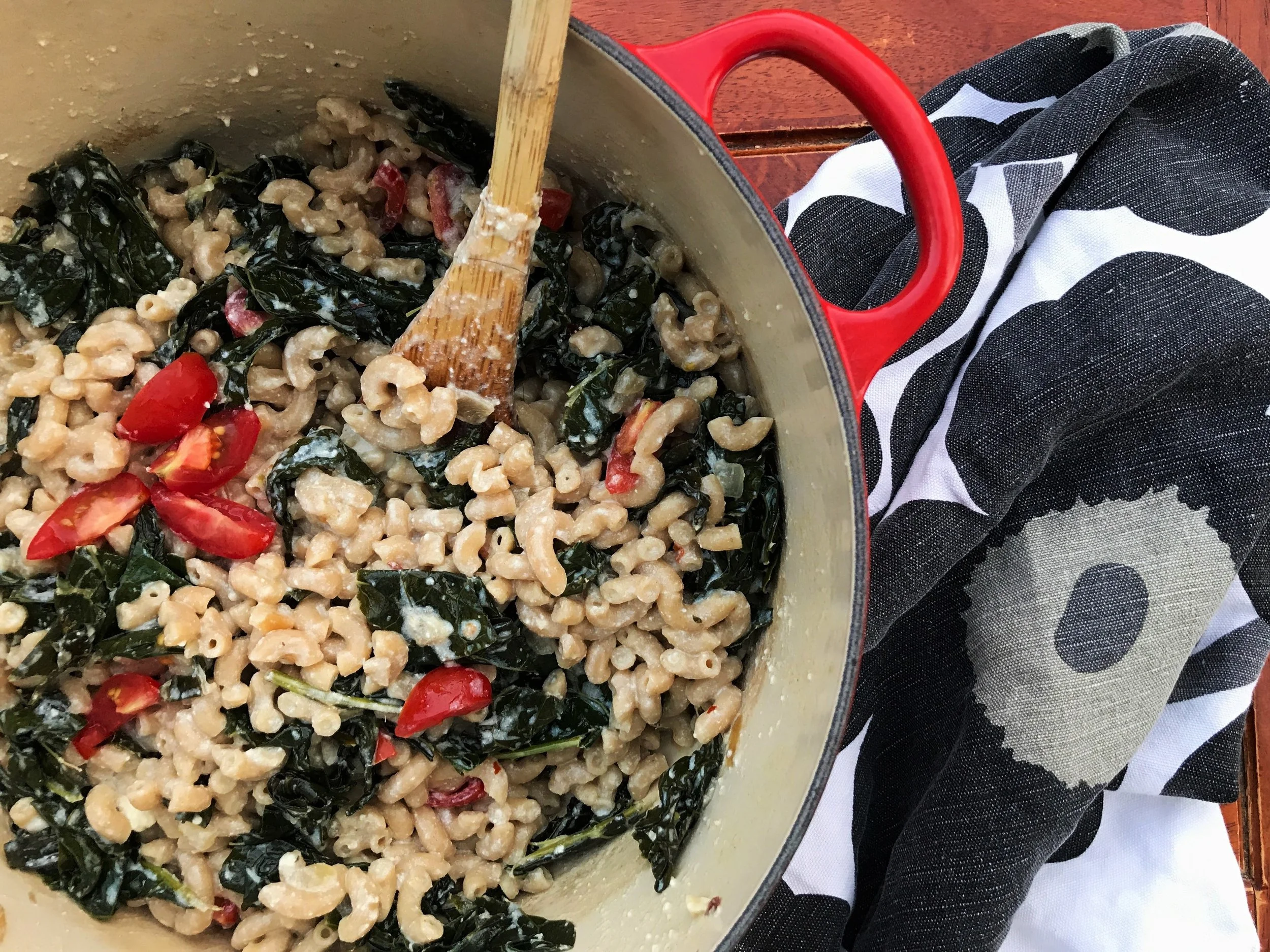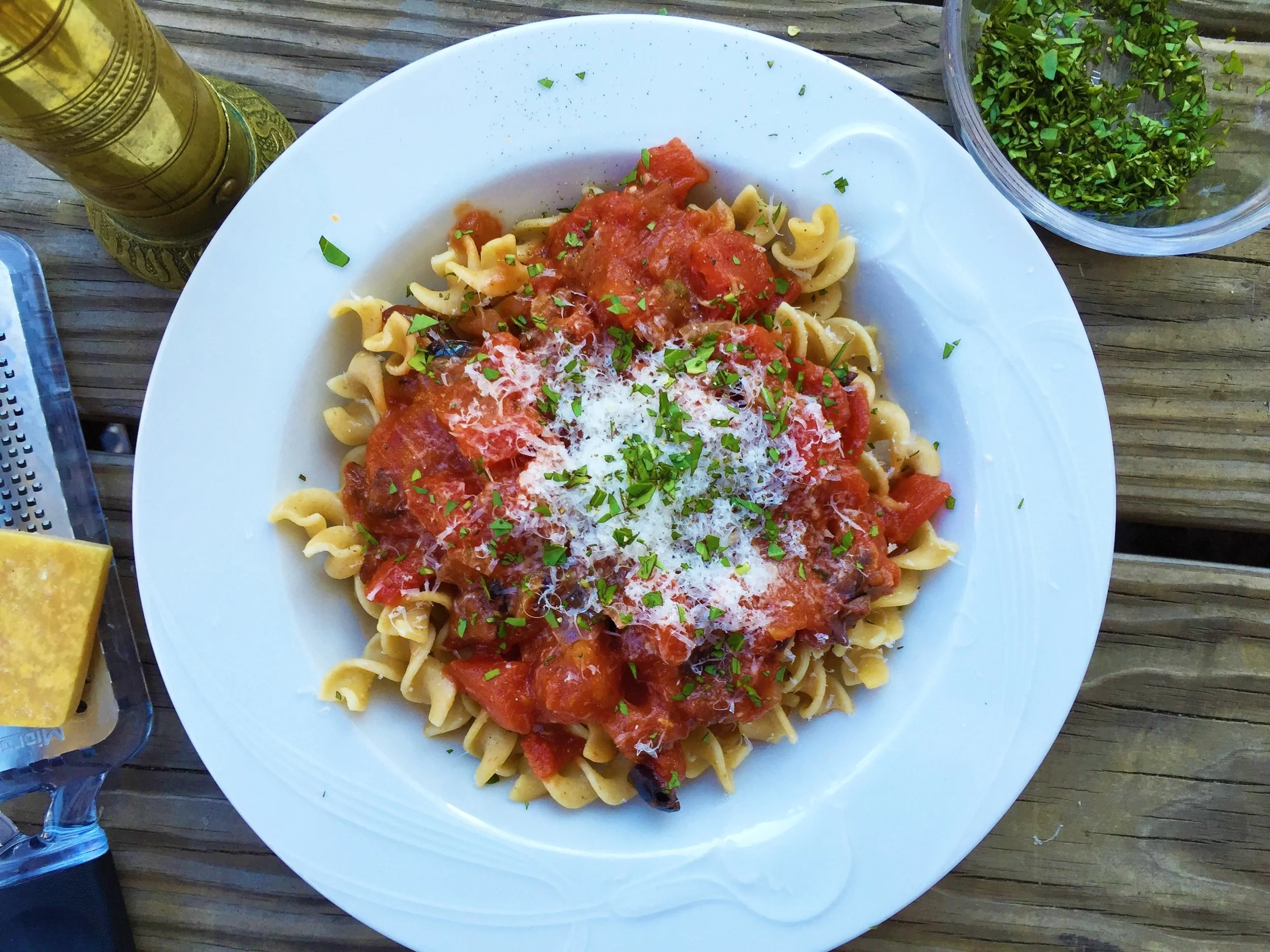Managing Your Pantry
Lynley Jones
I’ve edited this post as conditions have changed from “how to prepare just in case” to “what to do now that we’re here.” I hope this is helpful.
As a professional cook and former stay-at-home mom, I’ve pulled together the suggestions below for stocking and managing a pantry through an extended period of cooking at home. This is the list I’ve been using to shop for my own family, and keep us well stocked with the essentials we need to make nearly every meal at home.
Chickpeas (aka garbanzo beans), black beans and pinto beans from my pantry.
As we all transition from crisis mode to our “new normal,” it seems we’re still going to want to stay away from grocery stores and other crowded places as much as possible, with good reason. And if someone should get sick, we’ll still need a couple of weeks’ worth of groceries to get us through quarantine. So it still makes sense to keep a well-stocked pantry so you can make most meals at home.
My current approach is to get most of what I need at the farmers market. I’m there every week to help staff our Adventure Kitchen booth, and the market managers have done a great job reorganizing the market to minimize contact and maximize distancing. I try to get as much of our fresh produce there as possible, as well as meat, eggs, some cheeses, and more. I fill in with curbside pickup from local food businesses that now offer some grocery items (bread, milk, eggs, butter, more cheeses, olive oil, etc.), and I limit supermarket trips to stock up on things like cereal, canned goods, condiments and the like, to roughly every two weeks.
My strategy is still to keep 2-4 weeks of food on hand, so I only need to replenish about a week’s worth of supplies on any given shopping trip (or a bit more when I go to the supermarket). If you live in a small apartment, it might be more realistic for you to keep 1-3 weeks of food on hand.
Hope this is helpful:
In the Pantry
You’re going to want a pantry full of shelf-stable proteins, whole grains and storage-friendly fruits and veggies (like onions, apples and potatoes, plus raisins, dried cranberries, etc.) that you can combine to make meals from. A partial list of go-to items could include: canned fish, nut butters, pasta, dried beans, canned beans, rolled or steel-cut oats, nuts, coffee beans, salsa and canned tomatoes (pureed and whole plum).
You might want to stock up on flour, baking soda, baking powder, salt and sugar so you have everything you need for baking projects. You can make your own homemade pancake mix ahead, by combining the dry ingredients from this recipe and storing them in an airtight container (see notes at the bottom of the recipe for more detailed instructions).
Wine and beer for cooking (and drinking!) are good to have on hand.
Also, you’ll want to have plenty of non-food staples like freezer-safe plastic zipper bags, paper towels, aluminum foil, wrap and parchment paper. Plus dish gloves, dish soap, hand soap and tissues (obvs). (And while you’re at it, you might want to stock up your medicine cabinet too, of course.)
In the Freezer
Lots of frozen veggies and fruit. You’ll want to have plenty of produce in the freezer in case you’re not able to get out for fresh produce. And definitely include leafy greens you might not normally buy frozen, such as spinach, etc. You can easily throw these into cooked dishes that call for fresh greens.
Meats, fish, chicken, sausages, bacon, etc. And regarding chickens, this is exactly the type of situation in which it might be better to buy whole chickens vs. parts (keep reading for more about why).
Also, meals and dishes you’ve prepared ahead (ideas below), and ingredients for stock and soup (keep reading for more on this).
If you have enough space, consider freezing loaves of bread for sandwiches (bread keeps beautifully in the freezer, but not in the fridge). You could also freeze tortillas and wraps.
And, extra butter in the freezer is always a good idea.
In the Fridge
If you’re going to do some batch cooking to freeze for later, you’ll obviously be stashing some of the ingredients for that in the fridge. But this is also the place to keep lemons, limes, onions, garlic, shallots, ginger, potatoes, beets and citrus fruits so that they’ll last weeks longer. If you (like me) don’t have infinite fridge space, you can rotate these from dry storage into the fridge every few days as you use them (and then use them from the fridge first). Then if you suddenly find you can’t leave the house, stick the rest in the fridge and use from there.
Some hardy greens, like collards and kale, will last a couple weeks in the fridge, and then you can freeze the finished dish after you cook them.
Miso, fish sauce and Parmigiano-Reggiano are great flavor bombs, and last basically forever in the fridge. Other hard cheeses will also last a long time, so are also a great idea. (Softer cheeses will get moldy much faster.) Preserved meats like prosciutto, ham, salami, etc. also add lots of flavor and last for a long time.
Fresh eggs last for about a month, and are a super versatile protein to have on hand.
Look for the words “ultra pasteurized” on milk and coffee creamer. This means they’ve been ultra-heat treated (UHT), which means pasteurized at a higher temperature than the usual. This gives them a shelf life of 30-90 days from the date of pasteurization, which usually means at least a month from the date of purchase (but you should use them up in the usual amount of time once they’re opened). You’ll find them among the rest of the refrigerated dairy products at the store.
Yogurt is a great thing to have on hand. It will last a couple of weeks in the fridge, but to keep it for longer than that, you can freeze it in ice cube trays (good for smoothies) or divide it into smaller takeout containers (faster to defrost).
Don’t Throw That Out!
Now it’s time to play “pretend you’re living through the Great Depression” with me! You can freeze your trimmings, bones, scraps, etc. as you cook, to reuse in other dishes or to make stock later. The best strategy is to stash ingredients in separate, labeled, freezer-safe zipper bags, with all the air squeezed out. If you’re suddenly unable to shop for any length of time, trimmings and scraps can add nutrients to your food, help your stored food go further, and save you money too. Here’s a brief list of things you can freeze for later:
Bones from roasted or uncooked chicken, beef and pork. (But after they’ve been used once in soup or stock, they’re “spent” and you can toss them.) Trimmed fat and chicken skin can also be frozen and used later. In fact, in situations like these I actually prefer to buy whole chickens rather than chicken parts. Cutting the chickens into parts yourself will leave you with more to save and use for stock (like backs, necks, wings, etc.) and save you money because whole chickens are much cheaper per pound that chicken parts.
After you make chicken stock, strain the solids and let it cool. Once it’s room temperature, stick it in the fridge so that the fat will solidify. You can scrape it off the top, keep it in a covered container in the fridge and use it as an alternative to olive oil or butter for cooking (I’ve been using it to roast potatoes and saute vegetables). Chicken fat is super flavorful, and lets you stretch your other fats further.
Ends and trimmings of onions, carrots, celery, mushrooms etc. You can use these in stock or any dish where their role is to add flavor and then be strained out before serving. (Onion skins add color but no flavor, fyi.)
Herb stems! After you use the leaves from the thyme, parsley, tarragon or what-have-you in whatever dish you’re making, stash the stems in your freezer in a zipper bag with all the air squeezed out (labeled, of course). You can throw the whole stems into stock or soup for flavor, and then scoop them out before serving. Some herb stems have more flavor than others; usually, the more tender the more flavorful. (Parsley stems work beautifully in stock or soup.)
Immune Supporters
Beans, rice, pasta, spices, garlic and oranges from my pantry stash.
While there are no magic pills or silver-bullet superfoods to prevent COVID-19 or any other disease, the following are tried-and-true ingredients that generations of grandmothers (and increasingly, scientists) have known are good for our health and support our immunity. They also happen to be delicious, and have a good shelf life:
Alliums: Onions, garlic and shallots have been shown to enhance immune function and bring cancer-fighting and de-toxifying properties to the table as well.
Fermented foods: Miso, kimchi, sauerkraut, gochujang, fish sauce, vinegar and yogurt add lots of flavor and nourish our gut bacteria (which in turn supports our immune systems).
Spices: There are lots and lots of nutrients in good spices to support immune function and general good health. Whether you get your spices from us or somewhere else, the fresher the better, for good health as well as for flavor. Be aware that grocery store spices have often spent a year or more in a warehouse somewhere before getting to you, so small-batch suppliers are a better way to go. Buying whole spices and grinding them yourself (easy to do in a mortar and pestle) is a great strategy. Read the label to be sure the only ingredients are the spices themselves (no anti-caking agents or preservatives). At the top of the immune-supporting spice list are turmeric, cardamom, chile peppers, Ceylon cinnamon and cumin.
What to Cook
Below are recipes you can make from the things you’ve stashed away. You can sub your frozen veggies for fresh, or in some cases skip the fresh ingredients if you’re stuck at home without them, and just make the dish with the rest of the ingredients. When cooking with frozen veggies, you’ll have to work a bit harder if you want to develop char; for example, you may need to let the frozen water drain away before cooking, and/or position the veggies closer to the broiler than you would when cooking fresh.
All these dishes are loaded with nutrients for good health, plus lots of flavor. And they’re all filled with lots of love and good wishes for your continued good health and wellness.
Stay strong, my friend. We’ll get through this together.
Recipes to Cook from Your Stash:
The original version of this post included a PSA about handwashing and guidance on mask-wearing, sizes of gatherings, etc. Things have changed significantly since then - and keep changing! - so I’ve eliminated that. But please do stay home, get a good night’s sleep, keep washing those hands and take care of yourself.













































Half the flour in this recipe is whole wheat flour. This makes for a more substantial breakfast, without dramatically changing the taste. You can make a big batch and rewarm them for a quick, nourishing breakfast during the week.